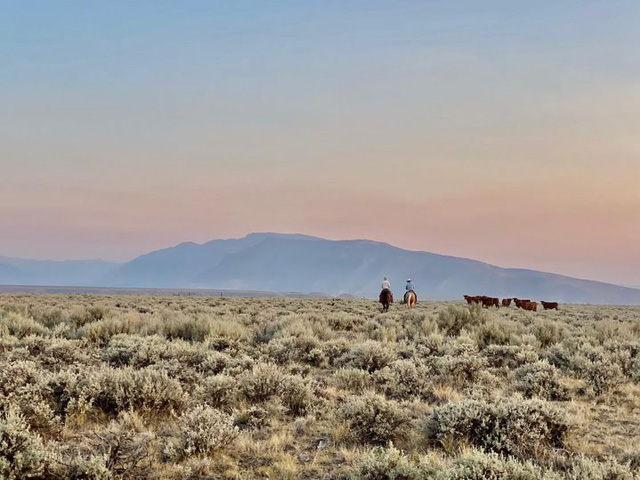Call the Market
Will the Cattle Inventory Report on July 23 Accurately Depict the Nation's Herd?
The biannual cattle inventory report is always one that makes the cattle market hold its breath. Producers ponder questions like, "what will analysts project for the nation's cattle herd? How will their projections influence the market today and in the future? And, do their conclusions accurately depict what the market's endured over the last six months since the last report?"
Given the stark differences that make running cattle in the East and West two very different realities this year, the report is going to be even tougher for analysts to pin down. Cattlemen in the East have been blessed with a fruitful year where moisture has been abundant, rain showers have been a regular occurrence and pasture conditions are superb. Meanwhile, in large cow-calf states like North Dakota, South Dakota and Montana, producers have endured a year that mimics that of the drought in 1980s. As of last week's USDA NASS Crop Progress and Conditions report, 89% of Montana's pasture/range conditions were called poor to very poor, while North Dakota was at 74% and South Dakota at 78%.
The Daily Livestock Reporter shared a glimpse of what might come from Friday's report, as it stated that, "Average pre-report estimates place all cattle and calves down 0.5% or 511,000 head to 101.689 million head, the lowest level in five years. Beef cows are expected to be down 1.1% to 31.697 million head with the range of estimates projected to be down 0.6% to 1.7%. Beef replacement heifers are expected to be down 1.0% to 4.356 million head with a range of flat down to 2.3%."
As of the January 2021 Cattle Inventory report, the top 10 states with the most beef cows were: Texas (4,685,000 head), Oklahoma (2,189,000 head), Missouri (2,035,000 head), Nebraska (1,900,000 head), South Dakota (1,799,000 head), Kansas (1,477,000 head), Montana (1,419,000 head), Kentucky (983,000 head), North Dakota (975,000 head) and Florida (929,000 head).
P[L1] D[0x0] M[300x250] OOP[F] ADUNIT[] T[]
With three out of the 10 largest beef cow states being in a severe drought, it wouldn't surprise me if Friday's report shared even slimmer beef cow numbers than what's been projected.
With some producers in the West being left with no other option but to load their cows up and send them to town, the difference in 2021's beef cow slaughter compared to 2020's shows an overwhelming difference. Based on the USDA's Cow Slaughter data, which is released every Thursday -- for the week ending July 3, year to date, in 2021 there have been 1,790,400 head of beef cows slaughtered. That's 148,500 more than what had been processed at this time in 2020, 199,800 head more than what had been processed at this time in 2019, 243,000 head more than what had been processed at this time in 2018 and 392,900 head more than what had been processed year to date in 2017.
Regardless of how Friday's report comes out, we know that the U.S. cow herd is undergoing a massive liquidation phase as producers in the West simply do not have the feed resources needed to run their cows. Producers who own their own grass and who sit well with their banks have been able to navigate the recent challenges of the cattle market fairly well. However, producers who are continuously in a bidding war for lease pasture, constantly looking for more hay and are trying to pay down numerous notes are at their breaking point as hay prices range anywhere from $200 to $400 per ton.
I don't share these realities with you to throw salt on an already open and irritated wound, but rather to inform you of the market's realities and to never overlook any pertinent information. My husband and I run cows in Northern Wyoming and the realities of drought have overtaken our region as well. As of July 20, our irrigation canals were shut off and it's a sobering feeling to see nothing but stock water running down the canal ditch amid 90-degree weather.
I know that some of you have already had to send cows to town; I know that some of you are wrestling with the decision currently, and I know that others of you are scrambling to see how you could avoid making that gruesome phone call to line up trucks, at whatever the cost.
What we cannot lose sight of is that these cycles -- these phases of hardship -- do not last forever. If you want to look at this from a true boots-on-the-ground mindset, we cannot forget the saying, "tough times make for tough men." If you want to look at the market from an analytical point of view and find comfort, then we know that cycles ebb and flow, and that tighter supplies (fewer cows) will mean more rewarding prices in the days ahead. If you want to look at this from a Biblical point of view, 1 Thessalonians 5:16-18 says, "Rejoice always, pray without ceasing, give thanks in all circumstances; for this is the will of God in Christ Jesus for you."
Figuring out how to weather the storm is what we must focus on moving forward.
ShayLe Stewart can be reached at ShayLe.Stewart@dtn.com
(c) Copyright 2021 DTN, LLC. All rights reserved.




